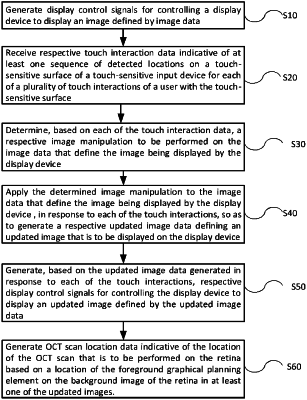| CPC A61B 3/0033 (2013.01) [A61B 3/0025 (2013.01); A61B 3/0041 (2013.01); A61B 3/102 (2013.01); A61B 3/1225 (2013.01); G06F 3/03547 (2013.01); G06F 3/0485 (2013.01); G06F 3/04845 (2013.01); G06F 3/04883 (2013.01); G06F 2203/04808 (2013.01)] | 20 Claims |

|
1. A non-transitory computer-readable storage medium storing instructions which, when executed by a computer processor, cause the computer processor to perform a method of designating a location of an optical coherence tomography (OCT) scan, by an OCT scanner, to be performed on a retina of an eye, the method comprising:
generating display control signals for controlling a display device to display one or more images, wherein generating of the display control signals is, based on image data defining a background image of a portion of the retina and a foreground graphical planning element for designating a location on the retina of the OCT scan to be performed;
receiving respective touch interaction data indicative of at least one sequence of detected locations on a touch-sensitive surface of a touch-sensitive input device for each of a plurality of touch interactions of a user with the touch-sensitive surface;
determining, based on each of the touch interaction data, one or more a respective image manipulations to be performed on image data defining at least one image currently being displayed by the display device, at least one of the image manipulations comprising at least one of:
a concurrent resizing of both the foreground graphical planning element and the background image by a common factor, while maintaining a location and orientation of the foreground graphical planning element with respect to the background image and without having moved the OCT scanner, wherein the concurrent resizing occurs in response to a touch interaction with the touch sensitive surface that selects only the background image, or
a panning of the image being displayed, the panning including commonly translating both the foreground graphical planning element and the background image while maintaining the location and orientation of the foreground graphical planning element with respect to the background image throughout the panning, wherein the panning is performed in response to a touch interaction with the touch sensitive surface that is outside of a predetermined distance from the foreground graphical planning element and which is the beginning of a drag operation;
applying the at least one image manipulation to the image data that define the image currently being displayed by the display device, so as to generate a respective updated image data defining an updated image that is to be displayed on the display device;
generating, based on the updated image data, at least one control signal for controlling the display device to display an updated image defined by the updated image data; and
generating OCT scan location data indicative of the location of the OCT scan that is to be performed on the retina based on a location of the foreground graphical planning element on the background image of the retina in at least one if the updated images.
|